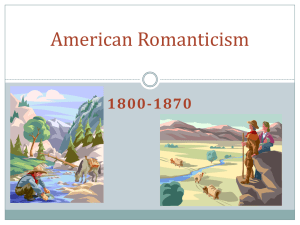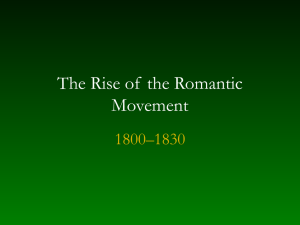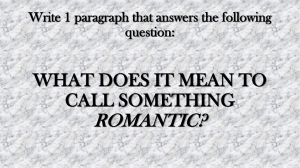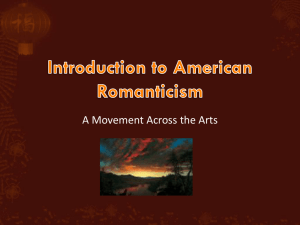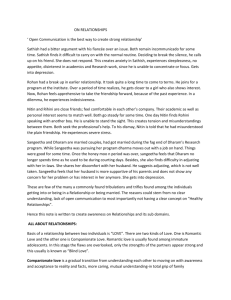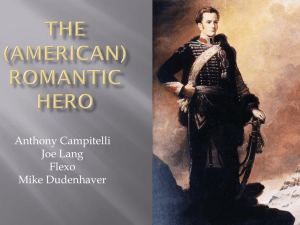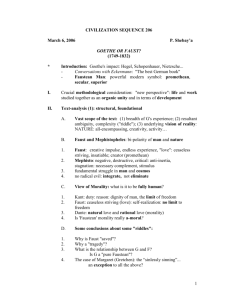American Romanticism - Summit School District
advertisement
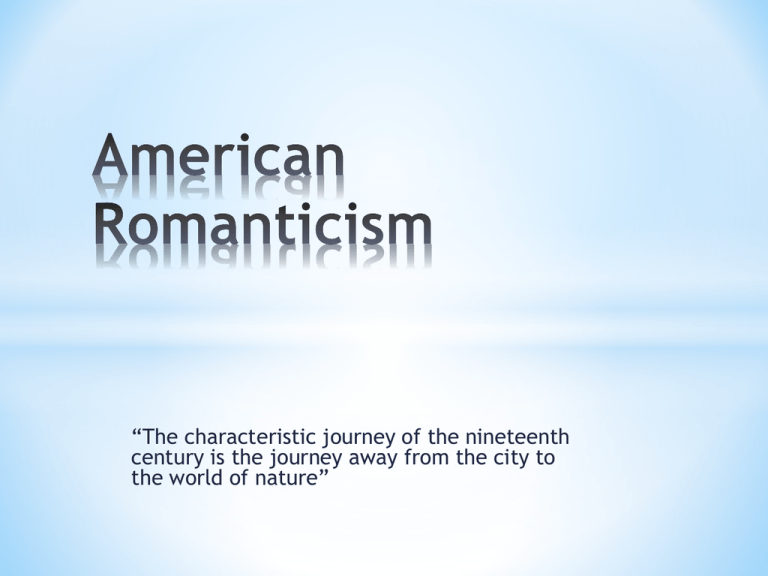
“The characteristic journey of the nineteenth century is the journey away from the city to the world of nature” * It is not single thing- difficult to define * A name given to a school of thought that considers the rational inferior to the intuitive * Imagination, spontaneity, individual feelings and nature were of greater value than reason, logic, planning and cultivation * A reaction against rationalism * * A movement that began in Europe developing distinct American characteristics out of our colonial past and the development of a new nation * Romantic sensibility sought to rise above “dull realities”: * Explored exotic settings, both past and present * Contemplated the natural world * * Independence * Straightforward moral certainty * Health * The idea of the frontier takes on great importance. * This geography of the imagination-town, country, frontier- played a powerful role in American literature and life, and it continues to do so today. * * The city was a place of moral ambiguity and corruption and death * The countryside became associated with independence, straightforward moral certainty, and health * This geography of the imagination-town, country, frontier-played a powerful role in American literature and life, and it continues to do so today. * * Characteristics of the Romantic Hero * A romantic hero must possess an understanding of his innerself or inner-world. * He must also understand the value of his experiences through emotions, intuition, and feelings rather than logically reasoning. * The audience must also be able to emotionally connect with the romantic hero on some level of emotion so that no matter the experience of the hero, the audience will relate to his experiences. *sophisticated, mysterious, and a bit dangerous. *a moody rebel, who can be very arrogant. *attractive to women who are drawn to his complicated personality, hidden conflicts, and secret past. *drawn to nature and filled with intuition. *reject the standard guidelines of society and adhere to their own code of morality and justice. * *We are NOT talking about Romantic as in Romantic Love *We are talking about Romantic as is from Roman Times * Watch for traits of the Romantic Hero in the character of Tom! An archetype is an original or fundamental imaginative pattern that is repeated through the ages. An archetype can be a plot, an event, a character, a setting, or an object. *Archetype *Archetype *“The Devil and Tom Walker” is an American version of the archetypal story of Faust, the sixteenth-century German philosopher who sells his soul to the devil for knowledge and power. * The story of a person who sells his or her soul to the devil for worldly gain is an archetypal plot. * The most famous and influential version of the tale is Faust, a play by Johann Wolfgang von Goethe (1749-1832). * Each retelling of the Faustian legend puts a different spin on the story, and the ending may change: * The Faust character, for example, may face eternal flames, find forgiveness and love, or somehow cleverly beat the devil. *Mood– the overall feeling or atmosphere of a story, play, or poem– may be the most difficult literary element to define. *After all, mood is intangible; you can’t point to mood in a text *It’s all about feeling *Literary Focus: Mood *In order to identify a story’s mood, start with the setting. *Pay close attention to the details of time and place, and ask yourself how the setting makes you feel. *Look carefully at the writer’s word choice. *For example: is a tree rotting or budding? *Then, consider the plot *Does it end happily, or does is present a bitter or tragic outlook on life?


